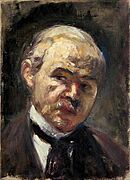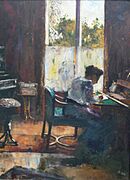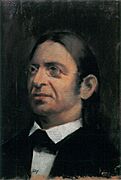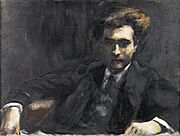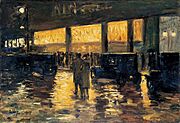Lesser Ury facts for kids
Quick facts for kids
Lesser Ury
|
|
|---|---|
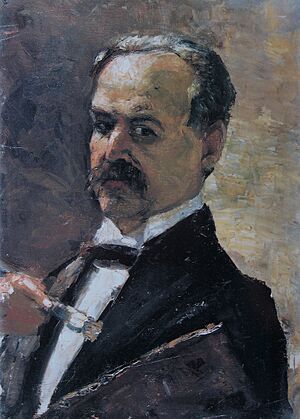
Self-portrait (1910)
|
|
| Born | November 7, 1861 Birnbaum, Province of Posen, Kingdom of Prussia
|
| Died | October 18, 1931 (aged 69) |
Leo Lesser Ury (born November 7, 1861 – died October 18, 1931) was a talented German painter. He was known for his unique style, which was part of the Impressionism art movement. Ury also created many prints. He was connected to the Düsseldorf school of painting, a famous art school.
Contents
Early Life and Art Training
Lesser Ury was born on November 7, 1861. His birthplace was Birnbaum, which was then part of the Kingdom of Prussia. Today, this area is called Międzychód in Poland.
His father was a baker. When Ury's father died in 1872, his family moved to Berlin. In 1878, Ury left school to learn a trade. The next year, he went to Düsseldorf to study painting. He attended the Kunstakademie, a well-known art academy.
Ury traveled to many cities to learn more about art. He spent time in Brussels, Paris, and Munich. In 1887, he finally returned to Berlin.
Becoming a Famous Artist
Ury had his first art show in 1889. At first, people did not like his work very much. However, a famous artist named Adolph Menzel supported him. Menzel's influence helped Ury win an award from the art academy.
In 1893, Ury joined the Munich Secession. This was a group of modern artists. They wanted to show art in new ways. Many similar "Secessions" were formed in Germany and Austria.
Ury moved back to Berlin in 1901. He began to show his art with the Berlin Secession. He had a big show there in 1922. By this time, more people liked his art. His paintings and pastel drawings were very popular.
Ury's Unique Art Style
Ury painted many different things. He created beautiful landscapes and city scenes. He also painted quiet indoor scenes. His style was impressionistic. This means he focused on light and color.
His paintings showed many moods. Some had soft colors, like people in a dim room. Others showed bright streetlights at night. He also captured the dazzling light of trees in summer. Ury also painted scenes from the Bible, but many of these are now lost.
Ury is especially famous for two types of paintings. He loved to paint busy cafe scenes at night. He also painted rainy streets. He would often paint the same scene more than once. He did this to sell copies while keeping the original. Sometimes, these quick copies were not as good. This made his reputation suffer a little.
Later Life
Lesser Ury was a quiet person. He did not trust people easily. As he got older, he became even more private. He passed away on October 18, 1931, in Berlin. He is buried in the Jewish Cemetery in Berlin-Weissensee.
Gallery
See also
- Tanya Ury


